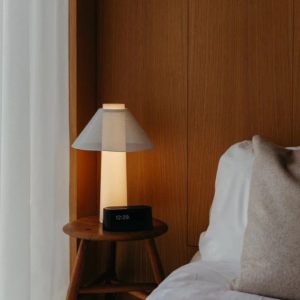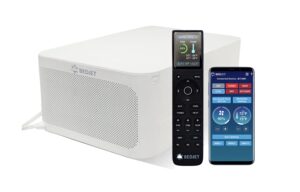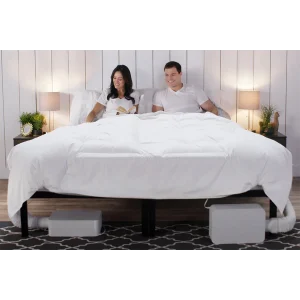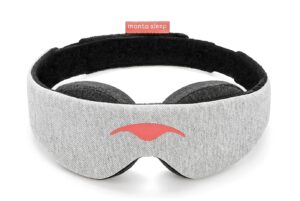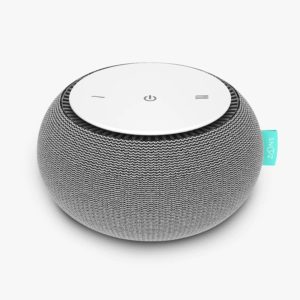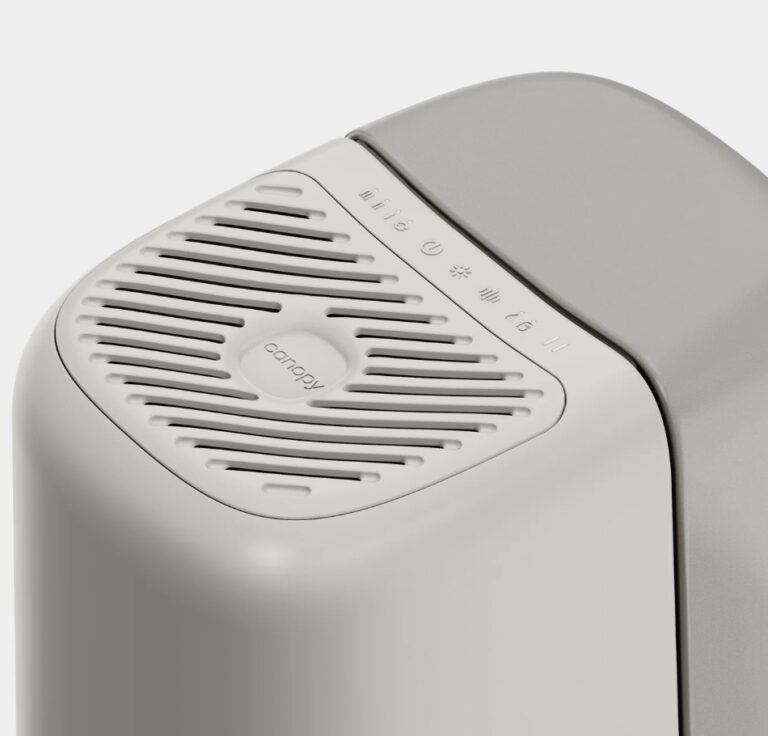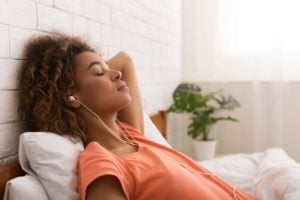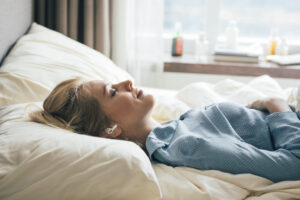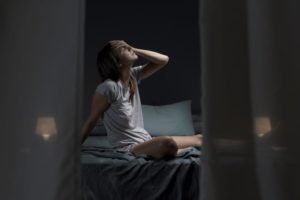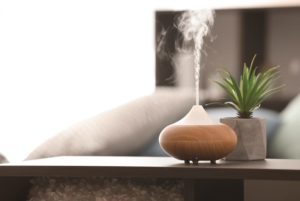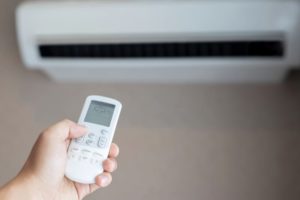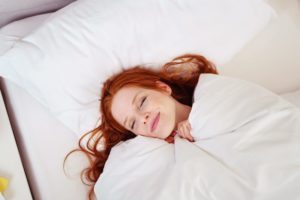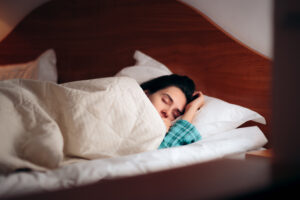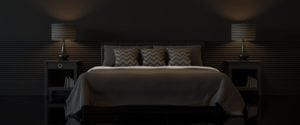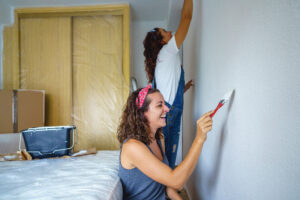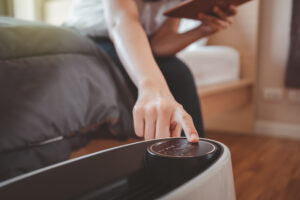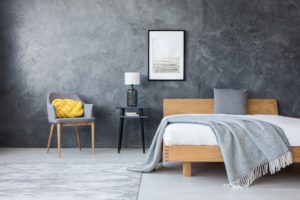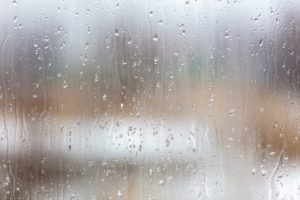When you buy through our links, we may earn a commission. Products or services may be offered by an affiliated entity. Learn more.
Humidifiers and Sleep
Humidifiers add moisture to indoor air and can be used to alleviate physical discomfort associated with an irritated nose, throat, and skin caused by low humidity. Dry indoor air can be caused by the climate where a person lives and heating by furnaces or wood stoves that cause indoor humidity to drop.
What Are the Benefits of a Humidifier While Sleeping?
“Humidifiers can serve many purposes. In addition to making it easier to breathe, they can help reduce eye and skin irritation along with providing ambient sounds to reduce sleep disruption.”
Dr. Abhinav Singh, Sleep Physician
A humidifier can reduce a number of discomforts caused by dry air, which may help a person sleep more comfortably:
- Relieves respiratory discomfort: A humidifier can help alleviate unpleasant symptoms associated with the flu and colds. Humidified air can loosen mucus, making it easier to expel through coughing. It may also unclog a stuffy nose and provide relief to those experiencing breathing issues from bronchitis.
- Alleviates dryness in the skin and eyes: Dry air can significantly reduce skin hydration, and using a humidifier can help alleviate scaly, itchy, and cracked skin. Humidified air can also combat eye dryness .
- Reduces nosebleeds: Dry air can dry out the membranes inside the nose, increasing the risk of irritation and nosebleeds . A humidifier can help reduce these effects.
- Eases discomfort from tonsillitis: Tonsillitis is a swelling of the tonsils common in children. Sleeping in a room with a humidifier can help lessen the throat pain caused by this condition.
- Provides white noise: Although distracting noises in the bedroom are not caused by dry air, a humidifier may provide background noise that can mask other disrupting sounds.
A humidifier may also alleviate some of the discomfort associated with the use of a positive airway pressure (PAP) machine used to treat obstructive sleep apnea, including a dry or sore mouth, dry skin, and nasal congestion. Fortunately, most PAP devices come equipped with a built-in humidifier.
What Is the Best Humidity Level for Sleep?
According to experts, the best humidity level for inside a house and bedroom is between 30% and 50% .
Low humidity can cause discomfort by drying out the eyes, skin, and mucus membranes. Additionally, it can make a person feel colder because sweat evaporation, which cools the body, happens easily in low humidity.
High humidity impedes the body’s cooling mechanisms as sweat does not evaporate as easily. A person’s sleep may be disrupted on a hot and humid night because their body cannot stay cool enough.
High humidity also promotes the growth of allergens in the bedroom including dust mites and mold. Reactions to allergens like mold may cause a skin rash, coughing, burning eyes, and stuffy nose, which can be disruptive to sleep.
How to Monitor Humidity Levels in Your Room
If you think low or high bedroom humidity may be affecting your sleep, you can easily test the moisture levels in your room with a humidity gauge. Also known as a hygrometer, you can buy these inexpensive, palm-sized devices at most hardware stores and online retailers.
What Type of Humidifier Should You Use?
There are three types of humidifiers . Your choice in humidifier depends on how much space inside your home you want to humidify:
- Central humidifiers: Central humidifiers are non-portable devices built into a house’s heating and cooling system and are designed to provide humidification to an entire house.
- Console humidifiers: Console humidifiers are large in-room humidifiers encased in a cabinet, designed to humidify one or more rooms.
- Portable humidifiers: Portable humidifiers are small and can be easily moved. They are designed to humidify a small space like a single room.
Additionally, there are four different ways that humidifiers add moisture to the air.
- Cool mist humidifiers: Also called an impeller humidifier, cool mist humidifiers work by forcing water through a fine screen which turns water into a mist.
- Ultrasonic humidifiers: These humidifiers vibrate water at an ultrasonic frequency, which creates a mist.
- Steam vaporizer humidifiers: This style of humidifier heats water, which creates steam that humidifiers the air.
- Evaporative humidifiers: Evaporative humidifiers work by blowing air over a moistened material, causing the water to evaporate into the air.
Cool mist and ultrasonic humidifiers may be a good choice for children’s rooms as there is no risk of accidents due to heated water or steam. That said, these humidifiers can aerosolize minerals and bacteria, which can be unhealthy if inhaled. Caution must be taken to minimize contaminants in their water tanks.
Steam vaporizers evaporate rather than aerosolize water, which greatly reduces the risk of any contaminants getting into the air. Be aware that steam vaporizers create steam, which can cause injury if care is not taken around the device.
Evaporative humidifiers do not use heat, and they do not disperse minerals or bacteria into the air. However, these devices may be bulkier and less portable than other humidifiers.
Tips for Sleeping With a Humidifier
Following some simple tips can help you safely get the most out of your humidifier.
- Protect children: Use a cool mist style humidifier in children’s rooms to avoid accidents with hot water or steam
- Optimize location: Your humidifier should be about six feet away from your bed and placed in a spot where air circulates, like near an air conditioning or heating vent
- Minimize contaminants: If possible, use distilled water in cool mist humidifiers to minimize mineral deposits and to reduce the release of minerals into the air.
- Avoid over humidification: Keep your room’s humidity below 50%. If surfaces in your room become damp, relocate or reduce humidifier use. Higher humidity and dampness may encourage the growth of mold and mildew.
Regular maintenance of your humidifier is important to ensure the humidified air it produces does not negatively affect your health. Remember to always unplug your humidifier before cleaning, disinfecting, or servicing.
- Daily maintenance: Empty and wipe dry your portable humidifier daily. Then refill the tank with fresh water. This will help minimize the growth of germs.
- Periodic cleaning: Clean your portable humidifier once every three days. Use a brush to scrub away any film or mineral residue in the tank. Wipe the tank dry before refilling with water. Cleaning helps minimize germs and mineral deposits in the water tank. Follow the manufacturers’ recommendations for servicing and cleaning console and central humidifiers.
- Cleaning solution: You can use a 3% solution of hydrogen peroxide or other manufacturer recommended cleaning agent to clean your water tank and any part of your humidifier that touches water. If you do use a cleaning agent, be sure to thoroughly rinse away all chemical residue before refilling it with water. This will prevent any cleaning chemicals from being dispersed into the air.
- Storing your humidifier: Thoroughly clean and sanitize your humidifier before storing it. Do the same when removing it from storage for use.
If you experience any respiratory issues while using your humidifier, discontinue use and contact a healthcare professional.

Still have questions? Ask our community!
Join our Sleep Care Community — a trusted hub of sleep health professionals, product specialists, and people just like you. Whether you need expert sleep advice for your insomnia or you’re searching for the perfect mattress, we’ve got you covered. Get personalized guidance from the experts who know sleep best.
References
8 Sources
-
Hull, N. M., Reens, A. L., Robertson, C. E., Stanish, L. F., Harris, J. K., Stevens, M. J., Frank, D. N., Kotter, C., & Pace, N. R. (2015). Molecular analysis of single room humidifier bacteriology. Water research, 69, 318–327.
https://pubmed.ncbi.nlm.nih.gov/25574772/ -
Sunwoo, Y., Chou, C., Takeshita, J., Murakami, M., & Tochihara, Y. (2006). Physiological and subjective responses to low relative humidity. Journal of physiological anthropology, 25(1), 7–14.
https://pubmed.ncbi.nlm.nih.gov/16617203/ -
Alter, H. & Messner, A. (2023, April 5). Patient education: Nosebleeds (epistaxis) (Beyond the Basics). In B. Wolfson (Ed.). UpToDate., Retrieved May 11, 2023, from
https://www.uptodate.com/contents/nosebleeds-epistaxis-beyond-the-basics -
A.D.A.M. Medical Encyclopedia. (2017, April 11). Tonsillitis. MedlinePlus., Retrieved May 11, 2023, from
https://medlineplus.gov/tonsillitis.html -
Weaver, T. (2022, December 15). Assessing and managing nonadherence with continuous positive airway pressure (CPAP) for adults with obstructive sleep apnea. In N. Collop (Ed.). UpToDate., Retrieved May 11, 2023, from
https://www.uptodate.com/contents/assessing-and-managing-nonadherence-with-continuous-positive-airway-pressure-cpap-for-adults-with-obstructive-sleep-apnea -
U.S. Environmental Protection Agency. (2022, September 14). A Guide to Indoor Air Quality: Care for Your Air., Retrieved May 11, 2023, from
https://www.epa.gov/indoor-air-quality-iaq/care-your-air-guide-indoor-air-quality -
Ahasic, A., Redlich, C., & Linde, B. (2022, August 8). Building-related illness and building-related symptoms. In M. Aronson (Ed.). UpToDate., Retrieved May 11, 2023, from
https://www.uptodate.com/contents/building-related-illness-and-building-related-symptoms -
U.S. Environmental Protection Agency. (2022, July 1). Use and Care of Home Humidifiers., Retrieved May 11, 2023, from
https://www.epa.gov/indoor-air-quality-iaq/use-and-care-home-humidifiers


